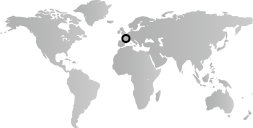In France, the first half of the twentieth century is dominated by the two world wars. The years between 1900 and 1950 witness the ongoing industrialization of France, as in other countries of Western Europe and in North America. Economically, politically, culturally, and socially, Paris continues to be at the center of French life, periodic efforts at decentralization notwithstanding. The postwar period in France is dominated by the towering presence of General Charles de Gaulle (1890–1970), who serves as president from 1944 to 1946, and 1958 to 1969. The processes of rebuilding and modernization that he implements are continued by his successors Georges Pompidou (1911–1974), Valéry Giscard d’Estaing (born 1926), and François Mitterand (1916–1996). The latter, in particular, makes an important mark on the capital city through his grands projets. Actually begun under Giscard d’Estaing, this series of public works updates French cultural institutions like the Musée du Louvre and transforms the city of Paris.
During the 1950s and ’60s, France, like other Western European countries, undergoes a process of decolonization when its former African and Asian colonies claim independence. Wars in Algeria and Indochina result, and contribute to the social and political tensions that erupt in the “Events”—specifically the general strikes and student revolts—of May 1968. As in other Western countries, an energy crisis, inflation, and high unemployment create economic malaise in the 1970s. The economic recovery of the mid- to late 1980s coincides with the movement toward European cooperation, which is manifest in the adoption of the euro by twelve of the fifteen European Union countries as the common unit of currency for electronic transactions in 1999.
The twentieth century opens with France, and especially the city of Paris, occupying a preeminent position in the art world. The French avant-garde in the period after 1900 pursues the development of artistic modernism that began during the nineteenth century. At the turn of the century, the Fauves, led by Henri Matisse (1869–1954), produce paintings characterized by the broad application of bright colors. At approximately the same time, Parisian artists, among them Pablo Picasso (1881–1973) and Georges Braque (1882–1963), pioneer the Cubist style. So important does Paris become in the early decades of the twentieth century with regard to the development of avant-garde aesthetics, that it is possible to speak of a School of Paris comprised of artists from many nations who are drawn to the city.
The persecution of Jewish artists in Germany and elsewhere in the years leading up to and including World War II brings many émigrés to Paris. The subsequent Nazi Occupation drives some away from Paris, to the United States. In the postwar period, the international significance of Paris as a center for art production is somewhat eclipsed by New York. Nonetheless, the French continue to make important contributions to photography, easel painting, and sculpture, as well as to design and architecture. The grands projets, among other works, are important for establishing postmodernism as an international cultural phenomenon during the last two decades of the century.


